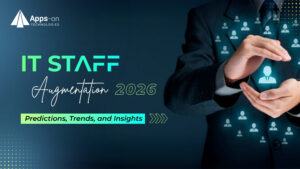IT Staffing & Augmentation 2026: Predictions, Trends, and Insights

As technology advances at lightning speed, companies are reshaping how they build and manage their tech teams. IT Staff Augmentation Trends 2026 reveal a dynamic shift in recruitment, deployment, and retention strategies across the globe. Businesses are looking beyond traditional hiring practices to embrace innovative models that align with digital transformation goals. This article explores the key predictions, trends, and insights that will define IT staffing and augmentation in 2026.
Why IT Staff Augmentation is More Relevant Than Ever
In an era where talent gaps are widening and technology lifecycles are shortening, IT staff augmentation has become a strategic necessity. Organizations no longer see it as a stopgap but as a sustainable model to scale teams up or down, accelerate projects, and tap into specialized skills without long-term commitments.
In 2026, staff augmentation will go beyond filling vacancies. It will drive innovation, cost efficiency, and competitive advantage. As companies focus on digital transformation, the ability to access niche expertise quickly will separate leaders from laggards.
Trend 1: AI-driven IT Staffing
Artificial Intelligence is transforming recruitment, onboarding, and workforce planning. AI-driven IT Staffing solutions will dominate the hiring landscape by 2026. These systems can screen thousands of resumes, assess technical competencies, and even predict cultural fit with greater accuracy than traditional methods.
Companies leveraging AI-driven hiring tools will benefit from:
- Faster hiring cycles: Automated resume parsing and skill matching.
- Reduced bias: AI algorithms built for fair hiring decisions.
- Predictive insights: Forecasting talent needs based on project pipelines.
This trend not only speeds up the hiring process but also improves the quality of hires, reducing turnover and increasing productivity. For IT leaders, integrating AI into staffing processes will no longer be optional — it will be essential to remain competitive.
Trend 2: Remote IT Staffing Models Gain Maturity
The pandemic accelerated remote work, but by 2026, Remote IT Staffing Models will be more structured, regulated, and strategic. Organizations will embrace hybrid teams, where augmented staff work seamlessly with in-house teams across time zones.
Key aspects of this trend include:
- Global talent pools: Companies hiring top engineers from anywhere.
- 24/7 operations: Distributed teams enabling round-the-clock delivery.
- Enhanced collaboration tools: VR meetings, digital workspaces, and real-time project dashboards.
These models also reduce costs and increase diversity, as companies can hire talent from emerging tech hubs worldwide. The challenge will shift from enabling remote work to optimizing productivity, security, and team cohesion in dispersed environments.
Trend 3: The Rise of Skills-first Hiring in Tech 2026
Degrees and credentials are taking a backseat as companies prioritize competencies over formal education. By 2026, Skills-first Hiring in Tech 2026 will be the norm. Employers will evaluate candidates based on demonstrable expertise, certifications, portfolios, and project outcomes rather than just their academic background.
This shift benefits both companies and professionals:
- Faster recruitment: Shorter cycles to verify capabilities.
- More diverse talent: Opportunities for self-taught developers and career changers.
- Better workforce agility: Teams built around current, in-demand skills rather than outdated qualifications.
As new technologies like quantum computing, edge AI, and blockchain evolve, hiring based on specific skills will allow companies to stay ahead of the curve.
What Companies Should Do to Prepare for 2026
To succeed in this new landscape, IT leaders must start laying the groundwork today:
- Invest in AI-powered recruitment platforms to streamline hiring.
- Develop policies for remote staff augmentation covering compliance, security, and performance measurement.
- Build skills-based career paths to attract and retain top talent.
- Foster partnerships with specialized staffing agencies that can deliver niche expertise on demand.
Preparation now will allow organizations to respond quickly to future challenges and seize opportunities as they emerge.
Predictions: What the IT Workforce Will Look Like by 2026
- A majority of tech teams will be hybrid, mixing full-time staff with augmented specialists.
- AI will handle up to 70% of candidate screening and onboarding tasks.
- Skills like AI engineering, cybersecurity, cloud-native development, and data analytics will be in highest demand.
- Freelance and contract professionals will represent a larger share of mission-critical projects.
These predictions highlight a more flexible, efficient, and globally connected IT workforce.
Conclusion: The Road Ahead for IT Staffing and Augmentation
The next few years will transform how companies approach tech talent. From AI-driven IT Staffing to Remote IT Staffing Models and the adoption of Skills-first Hiring in Tech 2026, organizations must be proactive to remain competitive.
By embracing these trends, IT leaders can build agile, future-ready teams capable of delivering innovation at scale. Ultimately, those who adapt quickly to evolving IT Staff Augmentation Trends 2026 will not just fill positions — they’ll unlock new possibilities for growth and transformation. Visit https://appsontechnologies.com/ for more information.